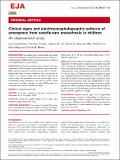| dc.contributor.author | Cornelissen, Laura | en_US |
| dc.contributor.author | Donado, Carolina | en_US |
| dc.contributor.author | Lee, Johanna M. | en_US |
| dc.contributor.author | Liang, Norah E. | en_US |
| dc.contributor.author | Mills, Ian | en_US |
| dc.contributor.author | Tou, Andrea | en_US |
| dc.contributor.author | Bilge, Aykut | en_US |
| dc.contributor.author | Berde, Charles B. | en_US |
| dc.date.accessioned | 2018-02-26T20:40:33Z | |
| dc.date.issued | 2017 | en_US |
| dc.identifier.citation | Cornelissen, Laura, Carolina Donado, Johanna M. Lee, Norah E. Liang, Ian Mills, Andrea Tou, Aykut Bilge, and Charles B. Berde. 2017. “Clinical signs and electroencephalographic patterns of emergence from sevoflurane anaesthesia in children: An observational study.” European Journal of Anaesthesiology 35 (1): 49-59. doi:10.1097/EJA.0000000000000739. http://dx.doi.org/10.1097/EJA.0000000000000739. | en |
| dc.identifier.issn | | en |
| dc.identifier.uri | http://nrs.harvard.edu/urn-3:HUL.InstRepos:34868854 | |
| dc.description.abstract | BACKGROUND Few studies have systematically described relationships between clinical–behavioural signs, electroencephalographic (EEG) patterns and age during emergence from anaesthesia in young children. OBJECTIVE To identify the relationships between end-tidal sevoflurane (ETsevoflurane) concentration, age and frontal EEG spectral properties in predicting recovery of clinical–behavioural signs during emergence from sevoflurane in children 0 to 3 years of age, with and without exposure to nitrous oxide. The hypothesis was that clinical signs occur sequentially during emergence, and that for infants aged more than 3 months, changes in alpha EEG power are correlated with clinical–behavioural signs. DESIGN An observational study. SETTING A tertiary paediatric teaching hospital from December 2012 to August 2016. PATIENTS Ninety-five children aged 0 to 3 years who required surgery below the neck. OUTCOME MEASURES Time–course of, and ETsevoflurane concentrations at first gross body movement, first cough, first grimace, dysconjugate eye gaze, frontal (F7/F8) alpha EEG power (8 to 12 Hz), frontal beta EEG power (13 to 30 Hz), surgery-end. RESULTS Clinical signs of emergence followed an orderly sequence of events across all ages. Clinical signs occurred over a narrow ETsevoflurane, independent of age [movement: 0.4% (95% confidence interval (CI), 0.3 to 0.4), cough 0.3% (95% CI, 0.3 to 0.4), grimace 0.2% (95% CI, 0 to 0.3); P > 0.5 for age vs. ETsevoflurane]. Dysconjugate eye gaze was observed between ETsevoflurane 1 to 0%. In children more than 3 months old, frontal alpha EEG oscillations were present at ETsevoflurane 2.0% and disappeared at 0.5%. Movement occurred within 5 min of alpha oscillation disappearance in 99% of patients. Nitrous oxide had no effect on the time course or ETsevoflurane at which children showed body movement, grimace or cough. CONCLUSION Several clinical signs occur sequentially during emergence, and are independent of exposure to nitrous oxide. Eye position is poorly correlated with other clinical signs or ETsevoflurane. EEG spectral characteristics may aid prediction of clinical–behavioural signs in children more than 3 months. | en |
| dc.language.iso | en_US | en |
| dc.publisher | Lippincott Williams & Wilkins, 2009- | en |
| dc.relation.isversionof | doi:10.1097/EJA.0000000000000739 | en |
| dc.relation.hasversion | http://www.ncbi.nlm.nih.gov/pmc/articles/PMC5728588/pdf/ | en |
| dash.license | LAA | en_US |
| dc.title | Clinical signs and electroencephalographic patterns of emergence from sevoflurane anaesthesia in children: An observational study | en |
| dc.type | Journal Article | en_US |
| dc.description.version | Version of Record | en |
| dc.relation.journal | European Journal of Anaesthesiology | en |
| dash.depositing.author | Cornelissen, Laura | en_US |
| dc.date.available | 2018-02-26T20:40:33Z | |
| dc.identifier.doi | 10.1097/EJA.0000000000000739 | * |
| dash.contributor.affiliated | Lee, Johanna | |
| dash.contributor.affiliated | Cornelissen, Laura | |
| dash.contributor.affiliated | Bilge, Aykut | |
| dash.contributor.affiliated | Berde, Charles | |


